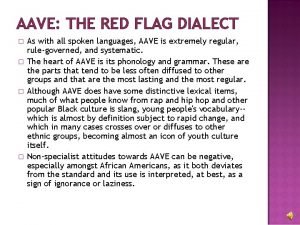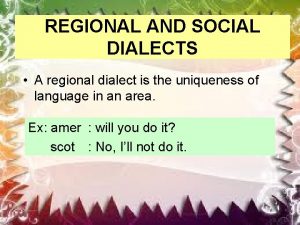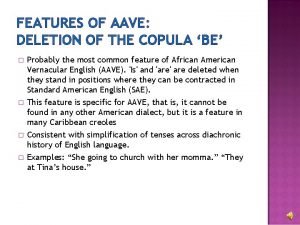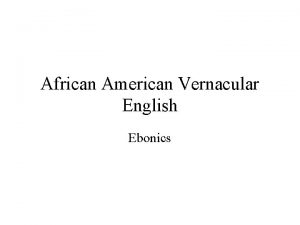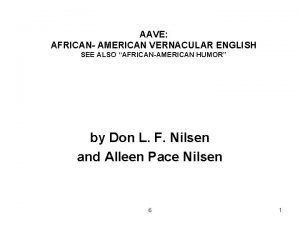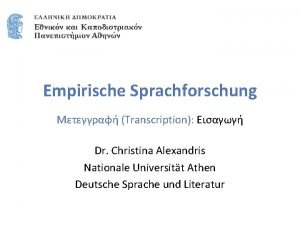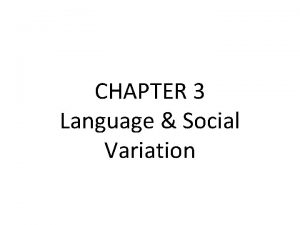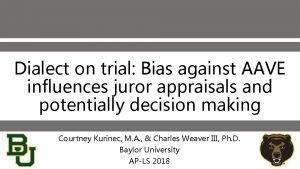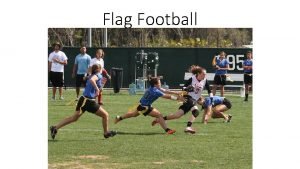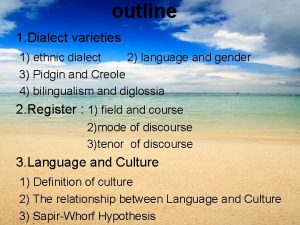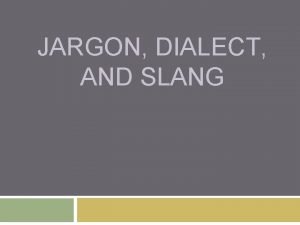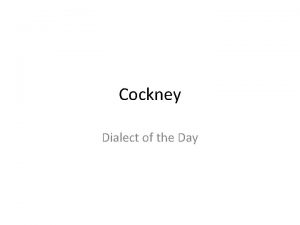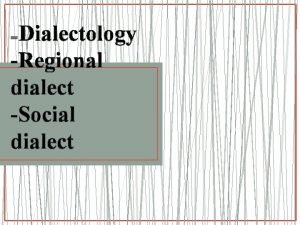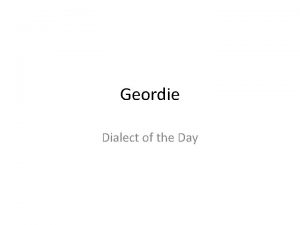AAVE THE RED FLAG DIALECT As with all










- Slides: 10

AAVE: THE RED FLAG DIALECT � � As with all spoken languages, AAVE is extremely regular, rule-governed, and systematic. The heart of AAVE is its phonology and grammar. These are the parts that tend to be less often diffused to other groups and that are the most lasting and the most regular. Although AAVE does have some distinctive lexical items, much of what people know from rap and hip hop and other popular Black culture is slang, young people's vocabulary-which is almost by definition subject to rapid change, and which in many cases crosses over or diffuses to other ethnic groups, becoming almost an icon of youth culture itself. Non-specialist attitudes towards AAVE can be negative, especially amongst African Americans, as it both deviates from the standard and its use is interpreted, at best, as a sign of ignorance or laziness.

THE IMPORTANCE OF AAVE "For the preachers, novelists, storytellers, poets, playwrights, actors and actresses, street corner hustlers, church-going grandparents, working mothers and fathers and schoolyard children, rappers, singers, barber-shop and beauty-salon clients who draw on it daily, AAVE is not simply a compendium of features, but the integral whole which Brown evocatively called 'Spoken Soul. '" (Rickford 1999: 12).

TERMINOLOGY Black English (term used by linguists from the 70 s through the 90 s) Ebonics (associated with nonlinguists, political movement of late 80 s into the 90 s; picked up by a lot of attack media and still used by them) African American Vernacular English (AAVE): term adopted by linguists in late 90 s and now widely embraced

ORIGINS & USERS � � “Creole” theory: AAVE arose from one or more slave creoles. These in term rose from slave/captor pidgins. � Major proponents: William Stewart, John Dillard, John Rickford, Walt Wolfram “Decreolization”—AAVE has features of many regional varieties of English, just in different combination, moving more closely back towards SAE. Not all African Americans speak AAVE, and not all AAVE speakers are African American. A significant number of whites, Hispanics, and Asian Americans who live and work closely together speak dialects that can be characterized as AAVE. In some Southern communities, the differences are more attitudinal than ethnic, phonological, etc.

GOOD RESOURCES ON AAVE � William Labov, Language in the Inner City, 1972 � Victoria Fromkin and Rodman, An Introduction to Language, Sixth Edition, Harcourt Brace, 1998 � Salikoko S. Mufwene , Rickford, Bailey, and Baugh. African. American English - Structure, History and Use. London and New York: Routledge, 1998 � John R. Rickford, African American Vernacular English Features, Evolution, Educational Implications. Malden, Massachusetts: Blackwell, 1999 � Walt Wolfram. “The grammar of urban African American Vernacular English. ” In Bernd Kortmann and Edgar Schneider (eds. ), Handbook of Varieties of English. Berlin: Mouton de Gruyter, 2004: 111 -132. (God bless Walt; he puts PDFs of almost all his articles on his web page!)

THE ANN ARBOR CASE (1979) � Excellent historical background: http: //comppile. org/archives/fforum 3(1)files/fforum 3(1)Bailey. pdf � Court recognition of differences between spoken and written Englishes � Court ordered school district to educate teachers about Black English and to identify students who were Black English speakers and “use that knowledge in teaching such students how to read standard English. ”

EBONICS � The term was first used in a book called Ebonics: The true Language of Black Folks, by Robert L. Williams (1975). It was actually coined two years earlier at the conference whose proceedings were published in that book. � The term was defined by the editor, Robert Williams (p. vi) as "the linguistic and paralinguistic features which on a concentric continuum represents the communicative competence of the West African, Caribbean, and United States idioms, patois, argots, ideolects, and social forces of black people. . . Ebonics derives its form from ebony (black) and phonics (sound, the study of sound) and refers to the study of the language of black people in all its cultural uniqueness. " � The term, which flourished for a while in the 1970 s (see the June 1979 special issue of the Journal of Black Studies, which was devoted to Ebonics), did not really catch on outside of the afrocentric community, and AAVE is more popular in linguistics.

THE OAKLAND CASE � � December 1996: The school board for the Oakland school system voted unanimously to recognize Ebonics as a second language, and the primary language of its African-American students, for "maintaining the legitimacy and richness of such language. . . and to facilitate their acquisition and mastery of English language skills. ” Intention was that teachers would be trained to recognize when students were using Ebonics, and would translate it into standard English, like they did with Hispanic students or others for whom English is a second language, thus teaching them English as a second language. Major political firestorm, both in California and nationally; U. S. Education Secretary Richard Riley argued, “Elevating Ebonics to the status of a language is not the best way to raise standards of achievement in our schools and for our students. ” Oakland was denied any federal funding to implement the program.

THE REACTION

WHAT DID THE OAKLAND CASE SHOW? � According to Walt Wolfram, � the intensity of people's beliefs and opinions about language and language diversity, � the persistent and widespread level of public misinformation about the issues of language variation and education � the need for informed knowledge about language diversity and its role in education and in public life. "Language Ideology and Dialect: Understanding the Ebonics Controversy", Journal of English Linguistics 26 (1998): 108 -121.
